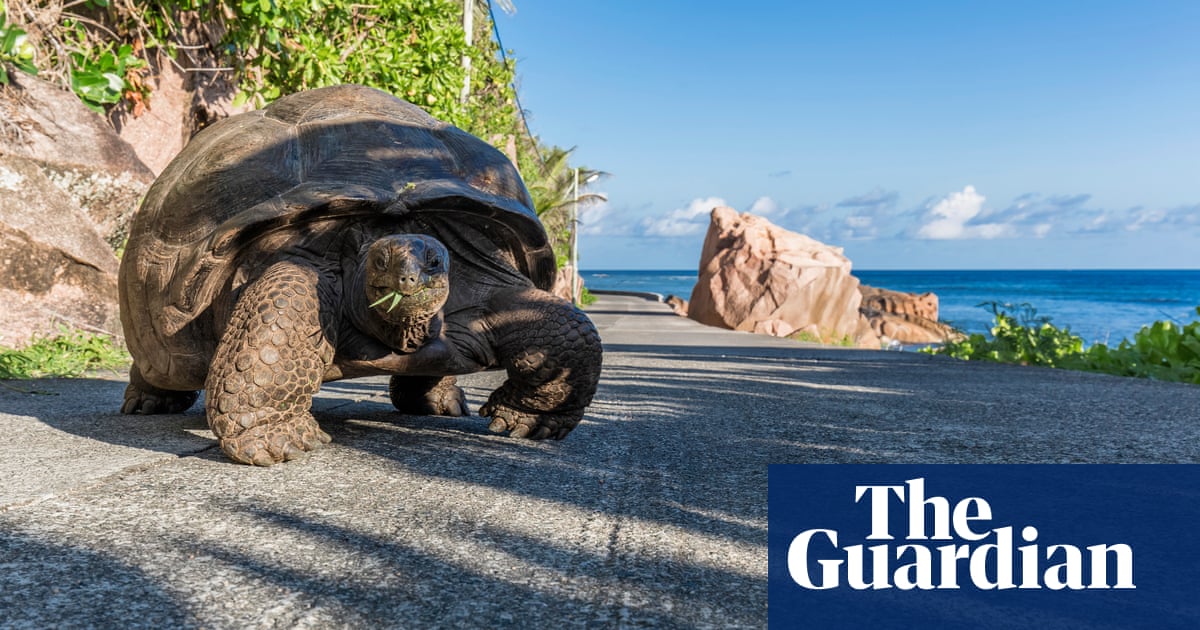
It was as unlikely a crime scene as one could imagine. The remains of seven giant tortoises scattered across a remote woodland in Devon, their helpless bodies abandoned in the understory.
The grisly discovery earlier this month has left police, local people and herpetologists baffled as to who dumped the reptiles and why.
The mystery has deepened as police have confirmed they are investigating whether there is a link between the deaths and the discovery of a giant tortoise in the same area – the National Trust-owned Ashclyst Forest – two years ago.
The animals – two of them were found on 8 January and five on 12 January – are believed to be Aldabra giant tortoises, one of the largest tortoise species in the world.
Andrew Highfield, the founder of the Tortoise Trust, who has studied tortoises for 40 years and was contacted by police for help, said it was a “strange and disturbing” case. After analysing images of the corpses for the Guardian, Highfield concluded the tortoises had been held in captivity for some time, possibly up to five years, in poor conditions.
Speaking from Spain, where he is studying Mediterranean tortoises, he said: “These animals from their appearance, they’ve been obtained as small juveniles and grown in captivity for a number of years. I would say probably at least five years possibly a bit more because they’ve got developmental problems. The carapace [shell] is very deformed and that’s because they have a condition similar to rickets – calcium deficiencies and vitamin D deficiency is associated with tortoises with poor-quality care and inappropriate conditions.
“It does tend to point to someone who got these animals and found them very difficult, but what is really strange, generally speaking, even in the condition they’re in, which was not good, it’s surprising that nobody has been putting feelers out to say ‘hey we’ve got these lovely animals can anyone take them’ and find an institution or informed private individual with resources to rehabilitate them.”
Highfield said Aldabras had the highest level of protection under the Convention on International Trade in Endangered Species of Wild Fauna and Flora, an international agreement between governments. It is legal to own them in UK, as long as importation paperwork is valid. They can sell for about £2,000 a tortoise.
Highfield said some criminals trade exotic animals on the side of mainstream criminal activity such as drug dealing.
A permit is required to breed them for sale and exhibition but Highfield said they were unlikely to be bred in the UK.
“This species is very, very difficult to breed in the UK. Very, very few people or institutions have actually done it. The adults are extremely large. They need the right type of conditions to breed and, frankly, providing that in the UK is really, really difficult.”
The Aldabra giant tortoise is endemic to Seychelles. Males can grow up to 250kg (550lb) and their shells can grow to about 122cm (48in) in length.
The temperature in Seychelles rarely drops below 20C (68F) all year round, whereas temperatures in Ashclyst Forest at the time of discovery had dropped below freezing. Highfield said there was no doubt the tortoises would have died from the cold, adding: “There’s no way they could have survived for more than a few hours.”
The cost of keeping just one of the tortoises would have been “astronomical”, he said. “These animals have to be kept in subtropical temperatures all year round, so you can imagine the energy costs.”
Highfield is baffled as to why the owner did not seek to give them away to a zoo, wildlife park or another private owner. His confusion was shared by walkers in the forest and visitors to Killerton house and gardens, the National Trust property two miles away on the same estate, who all expressed shock and surprise at the discovery.
One dog walker, who did not want to be named, said: “I saw it on the news, it’s so strange. We haven’t seen anything unusual, and come here three or four times a week. There is a lot of fly-tipping – there’s a washing machine in the woods.”
The 272-hectare (672-acre) forest where the reptiles were discovered is a large natural woodland pasture with commercial conifer plantations and rare wet woodland. The nearest village is Broadclyst, about three miles away, with the town of Cullompton about eight miles away.
National Trust staff found the animals, but they were too distressed to discuss the finding.
A statement from the National Trust said: “We can confirm that, sadly, seven rare Aldabra giant tortoises have been discovered dead on National Trust land near Exeter over the past few days. The tortoises are not native to the UK. The incident is now being investigated by police and we are unable to comment further at this time.”
It was not the first giant tortoise discovery in the woodland. In December 2021, Vale Vets Devon posted an appeal on its Facebook page for the owners of a giant tortoise that had been handed in in Cullompton. “At the Cullompton branch we have a giant breed of tortoise that has been handed in,” the post read. “This tortoise was found in the area of Ashclyst Forest.”
Vale Vets Devon has been contacted for comment.
Police confirmed they were investigating a potential link. A statement from police said: “Police received a report of a giant tortoise being found in the same area in December 2021, which was confirmed deceased by vets. As it was not a police matter, the log was closed. At this time, we are considering whether there is a link to the current inquiries.”












